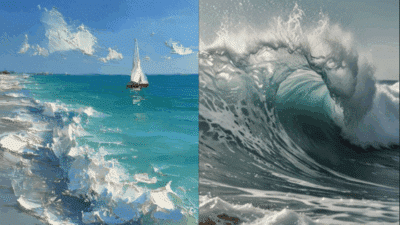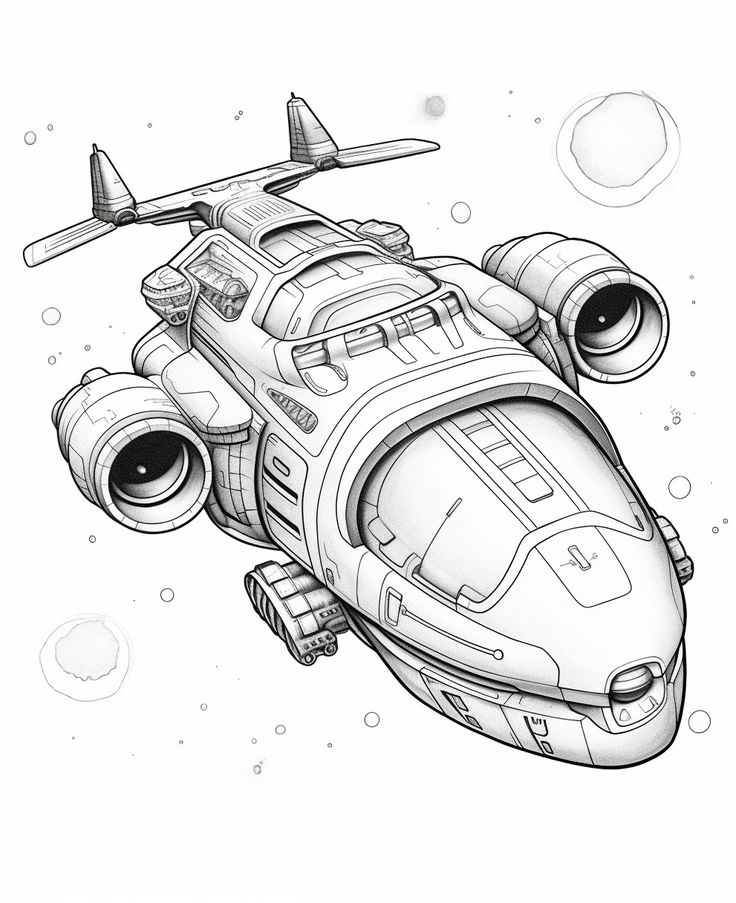
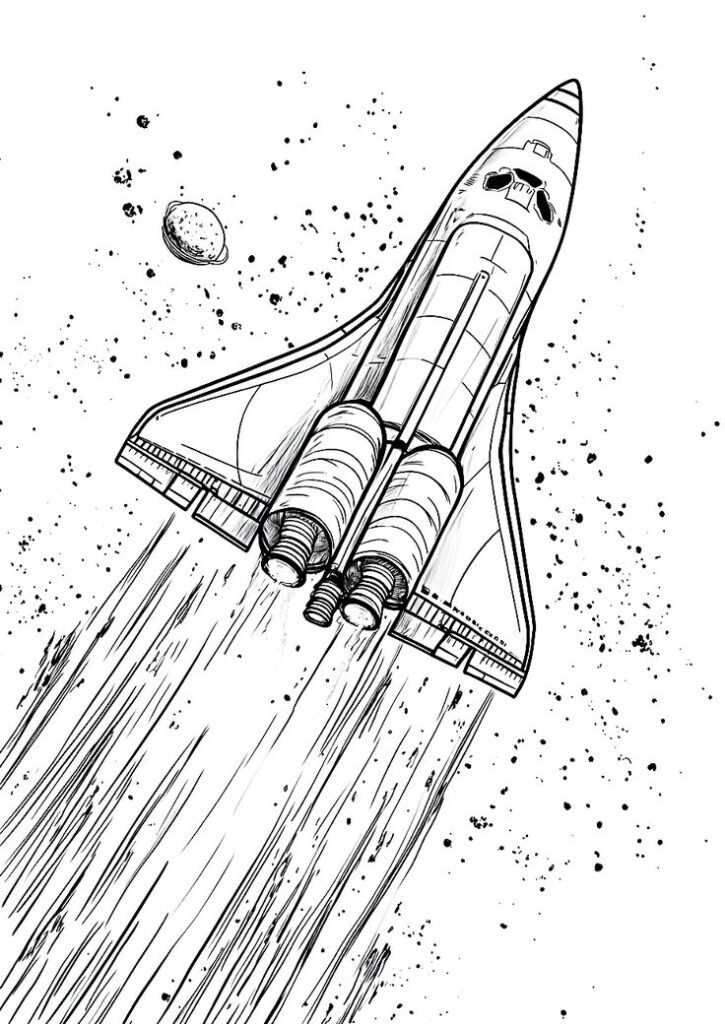
The allure of the cosmos, the boundless frontiers of interstellar travel, and the marvels of advanced engineering have captivated humanity for generations. Translating this fascination into tangible art, particularly in the realm of science fiction, offers a unique creative challenge. Learning how to draw a spaceship is not merely about sketching a futuristic vehicle; it’s about designing a functional marvel that reflects an entire universe’s lore, technology, and aesthetic. It requires a blend of artistic skill, imaginative foresight, and an understanding of foundational design principles. This guide will walk you through seven professional steps, transforming your conceptual visions into epic, believable starcraft. By meticulously following these stages, you will master the techniques to render spaceships that not only look impressive but also tell a story and immerse viewers in their futuristic narratives.
1. Research and Inspiration: Laying the Foundational Galaxy
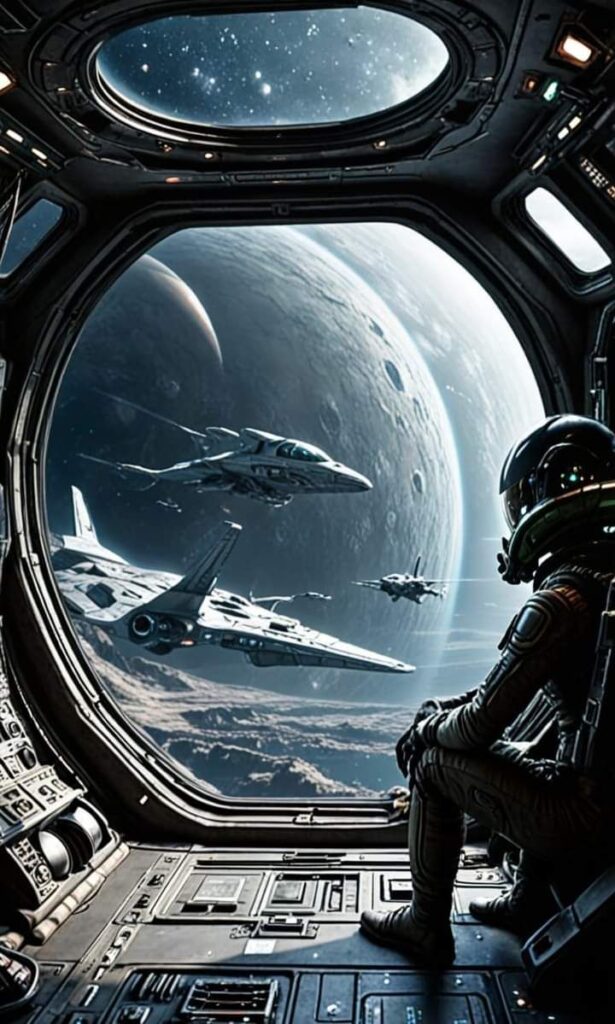
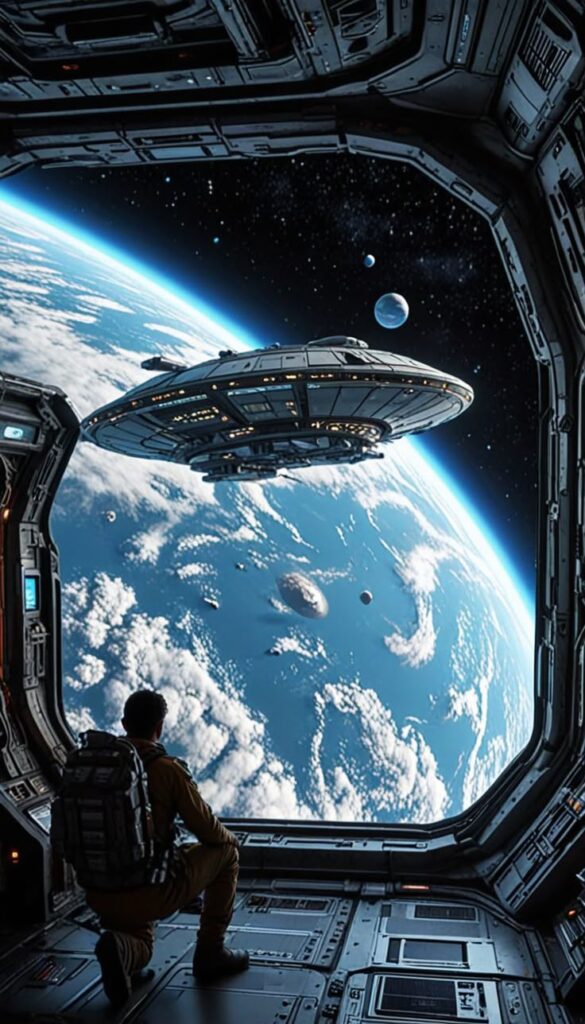
Before a single line is drawn, the most critical step is immersion. A truly compelling spaceship doesn’t materialize from a vacuum; it is born from a rich tapestry of influences. Begin by conducting thorough research, drawing from both the real world and the vast expanse of science fiction.
Explore Real-World Engineering and Aerodynamics: Look at existing aircraft, submarines, industrial machinery, and even insects or deep-sea creatures. Observe how form follows function in these designs. Analyze the purpose of various components: wings for lift, engines for propulsion, armor for protection, sensors for detection. Consider how heat dissipation, structural integrity, and material science dictate shapes and textures in real-world engineering. NASA’s spacecraft, military jets, and even commercial airplanes offer invaluable insights into functional design and efficient streamlining. These real-world elements can provide a grounded foundation for your futuristic concepts, making them feel more plausible despite their fantastical nature.
Dive into Science Fiction Lore: Study iconic spaceship designs from film, television, video games, and literature. Analyze what makes vessels like the Millennium Falcon, the USS Enterprise, or the Nostromo so memorable. Is it their distinct silhouette, their visible wear and tear, or the implied history embedded in their design? Pay attention to different sub-genres: sleek, pristine exploration vessels contrast sharply with battle-hardened warships or utilitarian cargo haulers. Each genre dictates a specific aesthetic and functional philosophy. For instance, a cyberpunk universe might feature gritty, jury-rigged ships, while a utopian future could showcase elegant, minimalist designs. Collect reference images, create mood boards, and articulate the specific “feel” you want your spaceship to convey. Is it an agile fighter, a massive dreadnought, a civilian transport, or an enigmatic alien craft? This initial conceptualization is paramount.
Brainstorm and Sketch Ideas: With your research at hand, start brainstorming. Don’t worry about perfection at this stage. Rapidly sketch various ideas, exploring different core shapes, engine placements, and overall configurations. Think about the ship’s purpose: Does it need large cargo bays? Prominent weapon systems? Panoramic observation decks? Let your imagination run freely, generating a wide array of possibilities. This exploratory phase allows you to sift through concepts, identifying elements that resonate with your vision and discarding those that don’t fit. Consider the backstory of your ship – who built it? What is its primary mission? What challenges has it faced? These narrative details can subtly inform its design, adding depth and authenticity.
2. Basic Form and Silhouette: Defining the Starcraft’s Soul

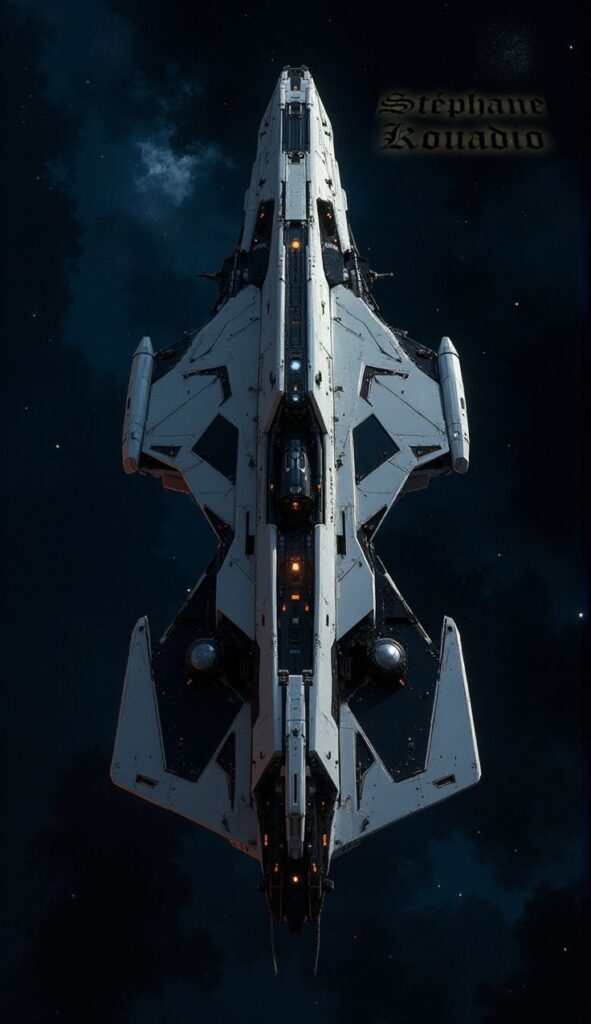
Once you have a general direction, the next step is to establish the spaceship’s fundamental form and distinctive silhouette. This stage is about blocking out the main volumes and ensuring the ship is recognizable even as a shadow.
Start with Simple Geometric Shapes: Begin by sketching basic geometric primitives: cubes, cylinders, spheres, cones. These forms serve as the building blocks for more complex structures. Think of the main hull as a large cylinder, the engine nacelles as smaller cylinders, or the cockpit as a domed sphere. Don’t focus on details yet; concentrate solely on the primary mass and how these basic shapes relate to each other in three-dimensional space. This initial “sculpting” with primitives helps you understand the ship’s volume and proportions.
Develop a Strong, Recognizable Silhouette: A powerful silhouette is crucial for an iconic design. Even without details, a great spaceship should be identifiable by its outline alone. Experiment with different arrangements of your basic shapes. Push and pull them, stretch and compress them, creating a dynamic and interesting overall shape. Does it have a predatory, angular profile, or a smooth, organic flow? Consider positive and negative space. The gaps and voids around your ship are just as important as the solid forms. A unique silhouette ensures your design stands out and is memorable.
Establish Primary Proportions and Balance: Determine the relationships between the main components. How big is the cockpit relative to the engines? Is the ship front-heavy or balanced? Ensure a sense of visual stability, even if the design is unconventional. A well-proportioned ship feels cohesive and functional. Avoid designs where elements feel tacked on or out of place. This stage is about finding the sweet spot between realism and artistic license, ensuring that the ship’s proportions logically serve its implied function.
Emphasize Asymmetry or Symmetry: Decide if your design will be predominantly symmetrical or asymmetrical. Symmetry often conveys stability, strength, and classic design, while asymmetry can suggest dynamism, unique functionality, or even a cobbled-together, utilitarian nature. Both approaches have their merits, and the choice depends entirely on the narrative and aesthetic you are aiming for. When practicing these foundational drawing skills, remember that understanding how to represent three-dimensional forms on a two-dimensional surface is paramount, whether you’re sketching a starship or drawing people. The principles of volume, mass, and proportion are universally applicable.
3. Establishing Perspective and Composition: Creating Depth and Dynamic Angles
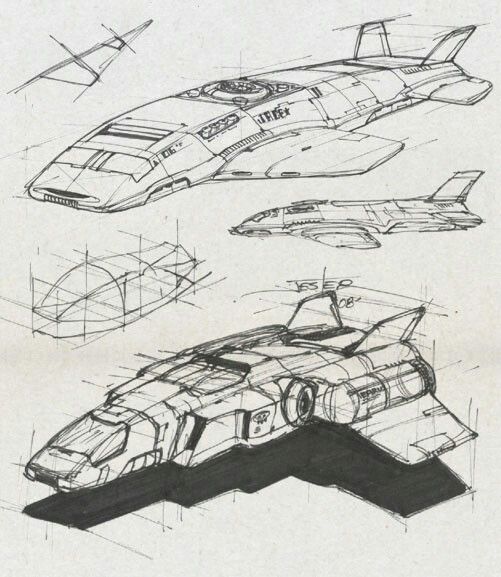
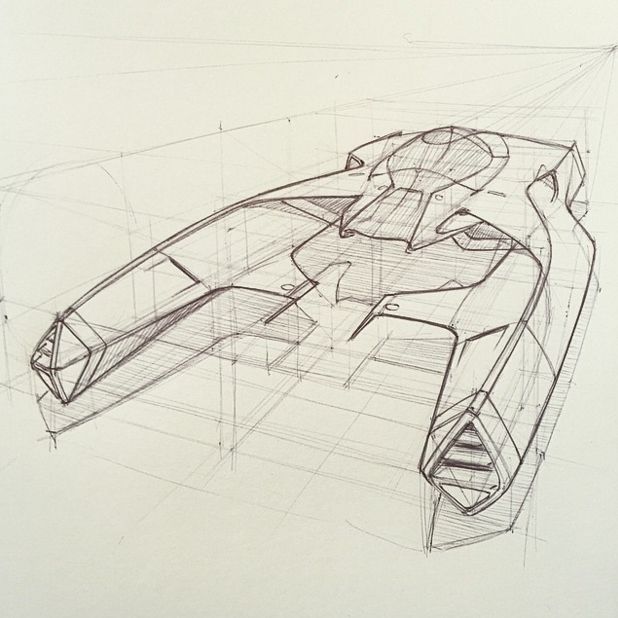
With the basic form established, the next crucial step is to place your spaceship within a convincing three-dimensional space. This involves mastering perspective and crafting a dynamic composition that highlights its key features.
Understand One, Two, and Three-Point Perspective:
- One-Point Perspective: Ideal for ships viewed head-on or from directly behind, emphasizing a sense of directness or speed. All lines recede to a single vanishing point on the horizon.
- Two-Point Perspective: Offers a more natural and dynamic view, showing two sides of the object receding to two separate vanishing points. This is excellent for conveying volume and depth.
- Three-Point Perspective: Adds a third vanishing point, typically above or below the horizon, creating extreme angles and a powerful sense of scale, especially when depicting a ship soaring high above or plummeting towards a planet. This is essential for dramatic, cinematic shots.
Practice drawing your ship from multiple angles using these perspective systems. This not only strengthens your understanding of its form but also allows you to find the most impactful views. Just as with beginner architecture drawing ideas, understanding perspective is fundamental to giving your drawing structural integrity and a sense of reality, even in a fantastical context.
Define the Horizon Line and Eye Level: The horizon line (or eye level) dictates where the viewer’s gaze is directed. A high horizon line makes the ship appear smaller and grander against a vast sky or space. A low horizon line makes the ship feel immense and imposing, towering over the viewer. Experiment with varying eye levels to evoke different emotions and convey scale effectively.
Craft a Compelling Composition: A strong composition guides the viewer’s eye and enhances the narrative.
- Rule of Thirds: Place your spaceship’s focal points (e.g., the cockpit, main engine, or a unique weapon) along the intersecting lines or at the intersection points of a grid divided into thirds, horizontally and vertically. This often creates a more balanced and engaging image than simply centering the object.
- Leading Lines: Use elements within your drawing (e.g., exhaust trails, nearby asteroids, or even implied lines from the ship’s own design) to direct the viewer’s eye towards the spaceship or its most interesting parts.
- Foreground, Midground, Background: Create depth by including elements in the foreground (e.g., a planet’s surface, debris), placing your ship in the midground, and developing a background (e.g., distant stars, nebulae, other ships). This layering adds richness and realism to the scene.
- Dynamic Angles: Avoid flat, head-on views unless specifically desired for a static, blueprint-like aesthetic. Tilting the ship, foreshortening elements, and using dramatic camera angles (like a worm’s-eye or bird’s-eye view) inject energy and excitement into your drawing. Consider how the ship interacts with its environment—is it cruising peacefully, engaging in a dogfight, or descending into an alien atmosphere?
By carefully applying perspective and compositional principles, you transform a flat drawing into a dynamic window into another world, allowing your spaceship to command attention within its cosmic stage.
4. Detailing Major Components: Bringing Function to Form
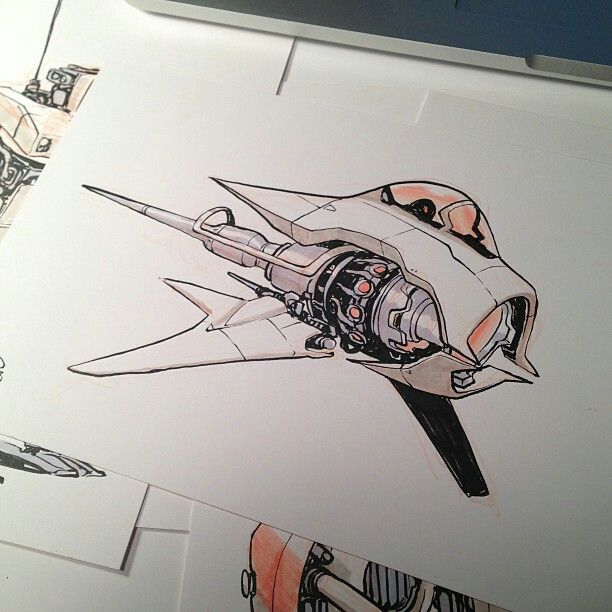
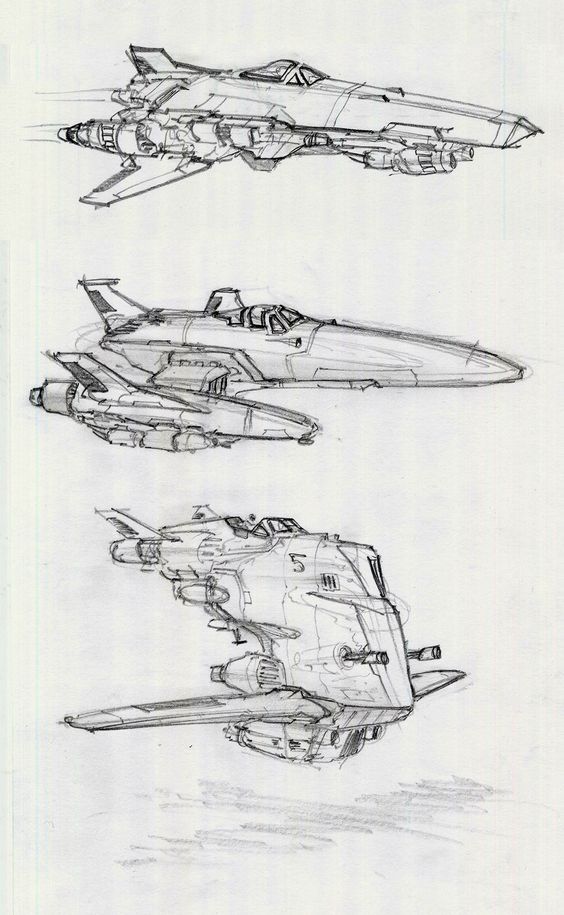
Once the overall form and perspective are solid, it’s time to begin adding the significant components that define your spaceship’s functionality and character. This stage moves beyond basic shapes to specific, recognizable elements.
Engines and Propulsion Systems: These are often the most visually striking components after the main hull. Decide on the type of propulsion: powerful plasma engines, sleek ion drives, or perhaps a more conventional rocket system. Think about their placement (rear, side-mounted, multiple arrays), their shape (circular, rectangular, organic), and how they connect to the main body. Are there visible thrusters for maneuverability? Exhaust ports? Consider heat sinks or protective plating around these high-energy areas. The design of the engines should reflect their power and the technology level of your universe.
Cockpit/Bridge and Observation Decks: The command center is the “face” of your ship. Its design often dictates the ship’s personality. Is it a sprawling panoramic window, a reinforced armored viewport, or a small, recessed observation bubble? Consider the visibility needed for the crew and how the cockpit integrates seamlessly into the ship’s hull. For larger vessels, think about additional viewing areas or sensor arrays. These areas should suggest the presence of inhabitants and their interaction with the ship.
Weapon Systems (if applicable): If your ship is combat-oriented, the weapons are crucial. Distinguish between different types:
- Energy Weapons (Lasers, Plasma Cannons): Often sleek, integrated into the hull, or mounted on turrets. They might have visible energy conduits or cooling vents.
- Kinetic Weapons (Missile Launchers, Railguns): Tend to be bulkier, with visible barrels, loading mechanisms, or missile bay doors.
- Defensive Systems: Shields emitters, point-defense turrets, or countermeasure dispensers can add complexity and realism.
Consider the scale of these weapons relative to the ship and their strategic placement for optimal firing arcs.
Landing Gear and Access Hatches: Even in space, ships often need to land or dock. Design retractable landing gear that looks robust enough to support the ship’s weight. Think about the mechanics of how it extends and retracts. Similarly, consider where crew and cargo enter and exit the vessel. These access points (ramps, airlocks, docking ports) should be logically placed and clearly articulated. They imply interaction and realism.
Cargo Bays and Utility Ports: If your ship is a freighter or research vessel, visible cargo bays, grappling claws, or manipulator arms can greatly enhance its functional appearance. These details ground the ship in a practical reality, suggesting its role beyond simply flying through space.
At this stage, your spaceship begins to transition from a generic outline to a specialized machine with a clear purpose. Each component should contribute to the overall narrative and functionality, making the design feel coherent and believable.
5. Adding Griebles, Panels, and Surface Texture: The Language of Detail
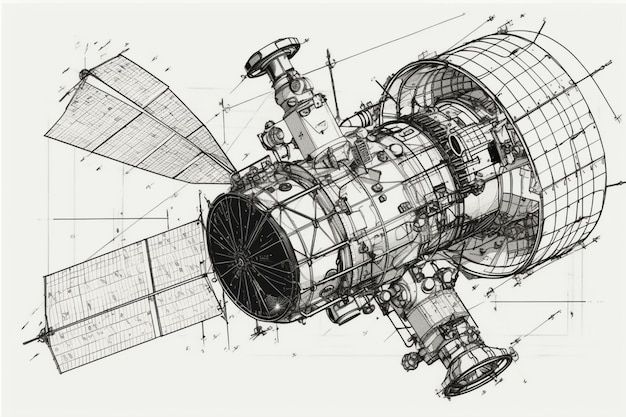
This is where your spaceship truly comes alive, gaining the intricate details that lend it realism, scale, and a sense of history. “Griebles” are small, complex, non-functional details that break up surfaces and imply underlying machinery, creating visual interest and suggesting technological complexity.
Introduce Paneling and Hull Plates: A smooth, monolithic surface rarely looks convincing. Break up large areas with panel lines, implying individual plates, armor sections, or access hatches. These lines can follow the contours of the ship, emphasizing its form, or create new patterns to add visual rhythm. Vary the size and shape of these panels to avoid monotony. Think about how these plates might be riveted, welded, or seamlessly joined. Overlapping panels can suggest layers of protection or modular construction.
Integrate Griebles and “Tech Bits”: Scatter small, intricate details across the surface. These could be:
- Vents and Grilles: For heat dissipation, atmospheric exchange, or engine exhaust.
- Antennas and Sensors: Small dish arrays, communication spires, or optical sensors.
- Pipes and Conduits: Running along the hull, suggesting power or fluid transfer.
- Small Thrusters: For fine maneuvering or attitude control.
- Service Hatches and Access Panels: Implying maintenance and repair needs.
- Minor protrusions and depressions: Breaking up flat surfaces.
The key with griebles is to use them judiciously. Overdoing it can make the design cluttered and confusing. Place them strategically in areas that would logically house such mechanisms or where you want to add visual complexity and break up otherwise bland surfaces. They should imply function without necessarily having a specific, discernible purpose to the viewer.
Suggest Surface Texture: Beyond actual details, imply the texture of the materials.
- Metallic Sheen: Indicate reflective surfaces with subtle highlights and gradients.
- Wear and Tear: For a used or battle-worn ship, add scratches, dents, scorch marks, and areas where paint might have chipped. Rust or corrosion might appear in certain environments.
- Dirt and Grime: Accumulation around vents, seams, or areas of heavy use can add significant realism and character. This tells a story of the ship’s operational history.
- Subtle Patterns: A very fine mesh pattern or subtle geometric texture can be applied to certain panels to suggest specialized materials or technologies.
This stage is about creating visual noise and interest without sacrificing clarity. Each added detail should contribute to the ship’s believability, reinforcing its purpose, age, and the harsh realities of space travel. The accumulation of these minute elements is what truly sells the illusion of a complex, functional machine.
6. Lighting and Shadows: Sculpting Form with Light
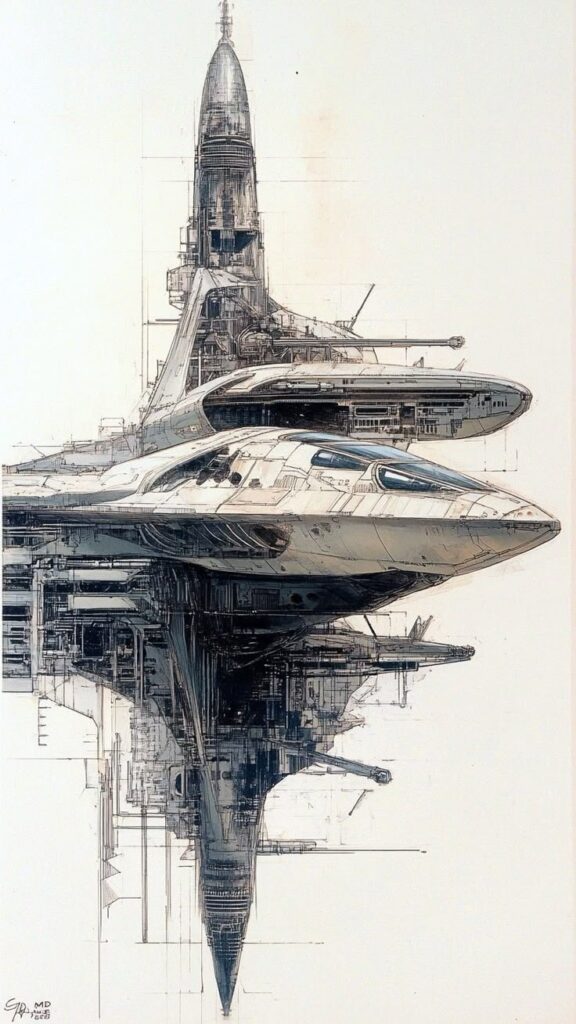

Effective lighting and shadows are paramount for transforming a flat drawing into a three-dimensional form with weight and volume. This step dictates the mood, atmosphere, and overall realism of your spaceship.
Establish a Clear Light Source: The very first decision is to define where your light source (or sources) is coming from. Is it a distant sun, a nearby nebula, artificial illumination from a space station, or even the ship’s own internal lights?
- Single Dominant Light Source: Often the simplest and most effective for dramatic effect. It creates clear highlights, mid-tones, and shadows.
- Multiple Light Sources: More complex but can add richness. Be careful to ensure they don’t flatten the form or create confusing shadows. Consider secondary light sources like planetary reflections or muzzle flashes.
The direction of light will profoundly impact how your ship looks. Light from above will create classic modeling, while light from below can be ominous. Backlighting can create a powerful silhouette and rim lighting.
Apply Core Shadows and Cast Shadows:
- Core Shadows: These are the darkest areas on the ship’s surface, away from the direct light. They define the curves and planes of the form. Observe how light wraps around rounded surfaces and sharply stops at hard edges.
- Cast Shadows: These are shadows projected by one part of the ship onto another part, or by the ship onto its environment (e.g., a wing casting a shadow on the main hull, or the ship casting a shadow on a planet). Cast shadows are often sharper closer to the object and diffuse as they extend further. They are vital for grounding the ship in its environment and conveying depth.
Introduce Mid-tones and Highlights:
- Mid-tones: These are the areas receiving diffused light or ambient light. They connect the highlights and shadows, providing a smooth transition across the surfaces.
- Highlights: These are the brightest points where the light source directly hits the surface at an angle that reflects maximum light back to the viewer. Highlights define the material (e.g., sharp, intense highlights for polished metal; softer, broader highlights for matte surfaces) and further emphasize the form.
Consider Ambient Light and Reflected Light:
- Ambient Light: In space, there’s often diffused light from distant stars or nebulae. This provides a subtle fill light that prevents shadows from becoming pure black voids.
- Reflected Light (Bounce Light): Light bounces off surfaces. A bright planet nearby might cast a subtle glow onto the underside of your ship, softening shadows and adding color complexity.
Mastering Digital Lighting: If working digitally, understanding how to apply and blend light layers can dramatically enhance your artwork. For detailed guidance on enhancing your drawings with digital illumination, refer to resources like digital illustration: simple shadows and lights that bring your drawing to life. This principle ensures your spaceship appears to exist within a tangible, illuminated world, rather than merely floating in a void.
Internal Lighting and Glows: Don’t forget any internal light sources, such as cockpit glows, engine flares, or weapon charging effects. These add dynamic light to the scene and give a sense of power and activity. The interaction of light and shadow is arguably the most powerful tool for conveying realism and emotion in your spaceship drawing.
7. Refinement and Final Touches: Polishing the Cosmic Masterpiece
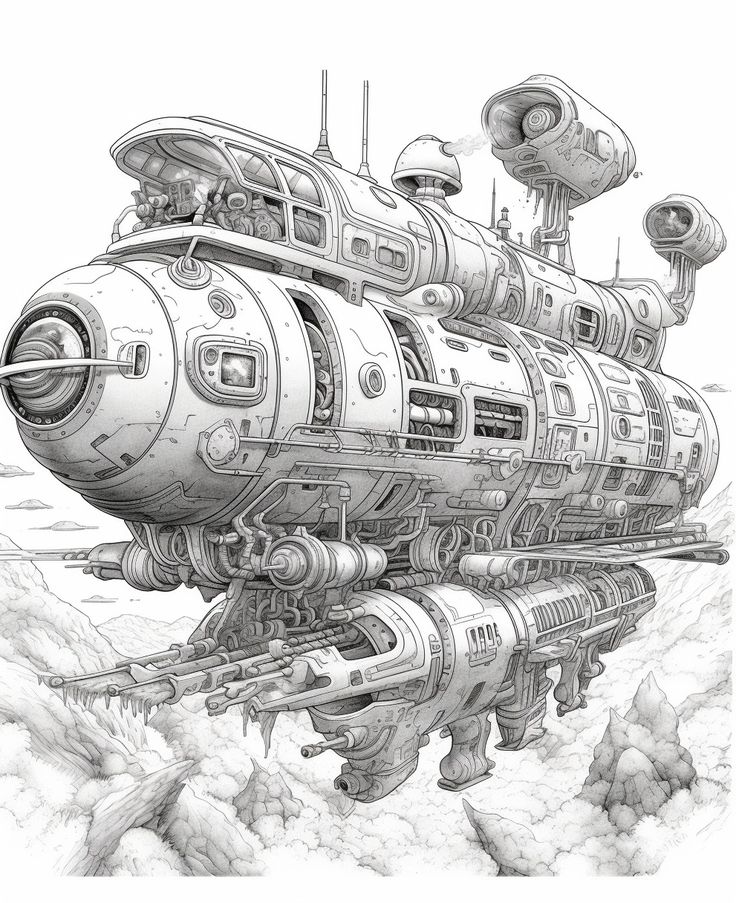

The final stage is where you elevate your drawing from a detailed rendering to a truly epic piece of sci-fi art. This involves meticulous refinement, adding atmospheric effects, and ensuring every element contributes to the overall impact.
Clean Up Lines and Edges: Go over your linework. Sharpen edges where appropriate, especially on hard surfaces and corners, and soften them where surfaces curve or recede. Ensure consistency in line weight, using thicker lines for foreground elements or areas of emphasis, and thinner lines for distant details or recessed features. A clean, confident line reinforces the professionalism of your artwork.
Add Textural Nuances and Micro-details: Zoom in and add very fine details that might not be immediately obvious but enhance realism upon closer inspection. This could include tiny rivets, very subtle panel gaps, minor cabling, small warning labels, or even subtle scratches and smudges on the glass of the cockpit. These minute details contribute significantly to the feeling of a real, functional object.
Implement Atmospheric and Environmental Effects:
- Engine Glows and Exhaust Trails: Make your engines feel powerful. Add bright, luminous glows at the exhaust ports, often accompanied by translucent heat distortions or energetic exhaust trails that hint at the ship’s movement and power.
- Starfields and Nebulae: A convincing backdrop of stars, distant galaxies, or swirling nebulae can dramatically enhance the sense of cosmic scale. Ensure stars are not uniformly bright; vary their size and intensity. Nebulae can add vibrant color and depth to the background.
- Asteroids or Debris: If appropriate, strategically placed asteroids or space debris can add visual interest, provide context, and even imply danger or history. Ensure these elements are in perspective relative to your ship.
- Lens Flares and Glare: If light sources are intense (e.g., a bright sun or powerful engine), subtle lens flares or glare can add cinematic realism, especially in digital art.
Consider Color and Rendering (if applicable): While the core instruction is “how to draw,” many artists naturally transition into coloring. If you plan to color, ensure your tonal values (light and shadow) are solid first. Then, consider a color palette that supports your ship’s lore and genre. Is it a muted, utilitarian grey, or a vibrant, alien hue? How do colors react to the established lighting? Understanding color theory is crucial for making informed choices that enhance the mood and impact of your piece. Apply textures and materials with appropriate colors, using variations in saturation and value to create depth.
Final Polish and Presentation: Step back frequently to view your artwork from a distance. Does it read well? Are there any distracting elements? Make any final adjustments to values, contrast, and sharpness. Ensure the overall composition is balanced and captivating. Sometimes, a subtle vignette or a slight adjustment to the overall lighting can make a significant difference. Present your work clearly, allowing viewers to appreciate the intricate details and the grand vision you’ve brought to life.
By meticulously attending to these final touches, your spaceship will transcend being a mere drawing and become an epic vision, ready to embark on interstellar adventures.
Drawing an epic spaceship is a journey of meticulous design, technical understanding, and creative expression. From the initial spark of inspiration to the final, intricate details, each of the seven professional steps outlined above plays a crucial role in bringing your starcraft to life. You’ve learned to ground your fantastical ideas in real-world engineering, define a compelling silhouette, master perspective for dynamic compositions, and imbue your vessel with functional components. Furthermore, you’ve discovered the power of griebles, paneling, and surface textures to create believable complexity, and the absolute necessity of lighting and shadows to sculpt form and establish mood. Finally, the refinement stage allows you to add those critical atmospheric effects and micro-details that transform a good drawing into an extraordinary piece of sci-fi art.
Embrace each stage with patience and passion. Experiment with different styles, technologies, and narratives. Remember that every line, every shadow, and every detail contributes to the story your spaceship tells. The universe is infinite, and with these professional techniques, your artistic capabilities to explore it are boundless. Now, take up your tools, look to the stars, and embark on your own voyage of cosmic creation. Your epic spaceship awaits its grand debut.
- 22shares
- Facebook0
- Pinterest22
- Twitter0



